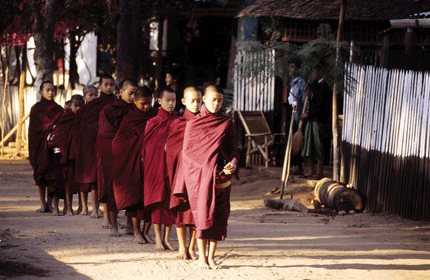Sangha under Siege
Monks feel the brunt of the regime’s brutality
As the sonorous sounds of bronze bells and wooden gongs dispel the early morning darkness, monks in maroon robes set off with their alms bowls on their daily rounds of the neighborhoods around their monasteries. This serene picture is part of the cultural tapestry of Burma, the “land of pagodas.”
 |
| Brothers in alms: Young monks on their morning round [Photo: AFP] |
The crackdown on the September demonstrations scattered the protesting monks—and at the same time shattered an age-old picture. The number of monks making their morning rounds has shrunk dramatically. Many monasteries are empty.
Relations between monks and laypeople have changed too. “Whenever we have contacts with the monks and monasteries, we are under surveillance,” said one Rangoon resident. “The authorities suspect us of supporting rebellion.”
The culture of Burma is widely considered to be synonymous with the Theravada form of Buddhism adopted from the Mon people following King Anawrahta’s capture of the Mon capital of Thaton in 1057. Theravada Buddhism came to play a central role in daily life, and every village in Burma now has its pagoda and a monastery, the traditional places for worship and religious education.
An ancient Sanskrit word meaning “justice” or “the law of nature,” dhamma is taught by monks to Buddhist devotees at monasteries. Recently, these sermons have become popular events in Burma—dhamma sermon VCDs and tapes are selling well all over the country.
Dhamma sermons are usually attended almost exclusively by elderly people; however, since the crackdown on peaceful demonstrators in September, more and more laypersons, especially youths, are turning up at monasteries to listen to Buddhist sermons. Sermons on dhamma are being given by well-known monks and abbots. In their talks, the monks often recount the words of Lord Buddha, telling their subjects that life is suffering and that, to atone for their sins, those who have committed evil acts will be condemned to “ape-nga-ye” (the Buddhist version of “hell”).
Attending dhamma sermons has become a way for Burmese people to show their defiance against the military government.
Traditionally, the most important duty of all Burmese parents is to make sure their sons are admitted to the Sangha on reaching the age of seven. A symbolic procession and ceremony of exchanging princely attire with that of an ascetic follow the example of the historical Buddha. Parents expect their sons to remain in the monastery and study the teachings of the Buddha as members of the Sangha for at least a few weeks.
Young men have another opportunity to join the Sangha at the age of 20, when they can be ordained as monks, disciples of the Buddha, perhaps devoting their whole lives to the order, sacrificing their normal existence for the task of keeping Buddhism alive. It’s a sacrifice that explains why the monks are such revered members of Burmese society.
Monks—considered “sons of Buddha”—were also the moral teachers of young and old alike until secular and missionary schools came into being during the British colonial administration. There has been a revival of monastic influence on Burmese society since the 1990s as a result of the country’s deepening socio-economic crisis.
Children from poor families that can ill afford fees, uniforms and books can qualify for free monastic education, while many leading monasteries also perform social work—notably Rangoon’s Maggin Monastery, which had a hospice and treatment center for HIV/AIDS patients until it was shut down by the authorities following the September demonstrations.
The protests that began in mid-August against sharp increases in the prices of fuel and other essentials and the monk-led uprising that followed were indicators of the dire state of the economy after 45 years of military rule. In an interview with The Financial Times, the UN’s representative in Rangoon, Charles Petrie, said: “People came out [to demonstrate] because the pain they are feeling is too much—they are suffering.”
Petrie was expelled from Burma for telling the truth, which the regime tried to smother with absurd claims of its own.
1 | 2 next page »
